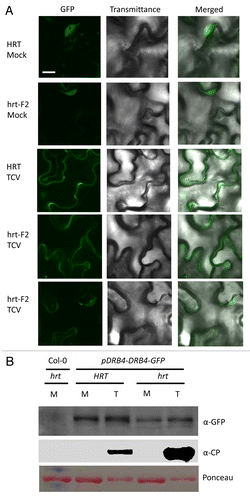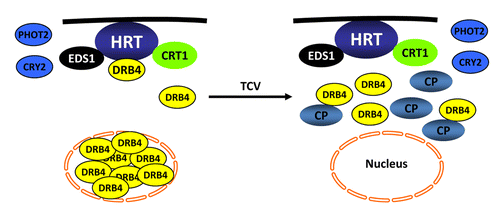Figures & data
Figure 1. The HRT phot2 plants support increased replication of virus. Western blot showing relative CP levels in TCV infected Col-0 (susceptible), Di-17 (resistance) and HRT phot2 plants. Leaves were sampled at 3 dpi. Ponceau-S staining of the western blot was used as the loading control. This experiment was repeated twice with similar results.

Figure 2. TCV inoculation increases the cytosolic pool of DRB4. (A) Confocal micrographs showing localization of DRB4-GFP in mock- or TCV-infected Arabidopsis plants. The leaves were analyzed at 3 dpi. The experiment was repeated twice (4 replicates per experiment) with similar results. Scale bars, 10 µM. (B) western blot showing DRB4-GFP and CP levels in mock (M)- and TCV (T)-infected transgenic plants expressing DRB4-GFP via self-promoter. This experiment was repeated twice with similar results.

Figure 3. A sketch of components involved in HRT-mediated resistance signaling against TCV. HRT is present on the plasma membrane (shown by black line) and interacts with EDS1, CRT1, and DRB4 proteins. Of these, DRB4 is primarily present in the nucleus, EDS1 is both nuclear and cytoplasmic, whereas CRT1 is on endomembranes. TCV-induced resistance response is initiated in the presence of TCV-CP. Upon recognition of TCV-CP, majority of the DRB4 relocalizes to cytoplasm, where a small pool of DRB4 interacts with CP. The presence of CP also prevents HRT-DRB4 complex formation but has no effect on HRT-EDS1 and HRT-CRT1 interactions. EDS1 potentiates HRT-mediated cell death response and acts redundantly with salicylic acid to regulate HR to TCV. Mutations in DRB4, CRT1, and the blue-light photoreceptors CRY2 and PHOT2, reduce HRT level. Consequently the mutant plants are unable to regulate HR or replication of TCV. No interaction has been detected between CRY2/PHOT2 and HRT, suggesting that these proteins stabilize HRT by inhibiting a negative regulator that mediates degradation of HRT.

